Knowing how to grow sprouts at home is a simple skill that everyone should have in their arsenal.
Gardening is therapy for me.
But I get it that many folks can’t have a big garden. Heck, I know Jill has a love/hate relationship with gardening in the wacky Wyoming weather, and I get it if gardening isn’t your “thing” at all.
But today we’re talking about how you can do some very easy, unbelievably productive “gardening” right on your kitchen counter.
This is gardening that everybody can do. Anywhere.
In case we haven’t “met” yet, btw, I’m Michelle Visser, a member of The Prairie Homestead Team. I get to work remotely with Jill from my little rural homestead in the middle of New England, where I often loose track of hours in my family’s large vegetable garden. I also write over on SoulyRested.com, I’m the author of Sweet Maple (affiliate link), and today, I’m giving you the sweet lowdown on sprouting.
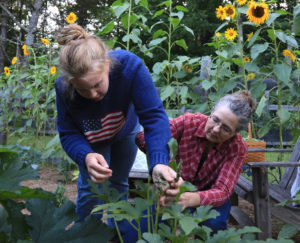
Right now, only through Sunday, March 22nd, you can grab my favorite sprouting kit at 15% off! Just go here and use coupon code SPROUTS15.
** FYI: this post contains affiliate links to products we use and recommend. Go here for the exciting legal language all about that if you’re into that sort of thing. Oh, and suffice it to say, I am not a nutritionist or medical professional, just explaining the fun facts I’ve learned about sprouts from folks who do seem to know these awesome things. **
This should be happening in kitchen corners across the country today.
When the produce section was missing a few essentials last week, even before the national pandemic was causing the shortages it is today, I came home and pulled out my sprouting trays and bags of sprouting seeds and got busy growing layers of fresh, green goodness.
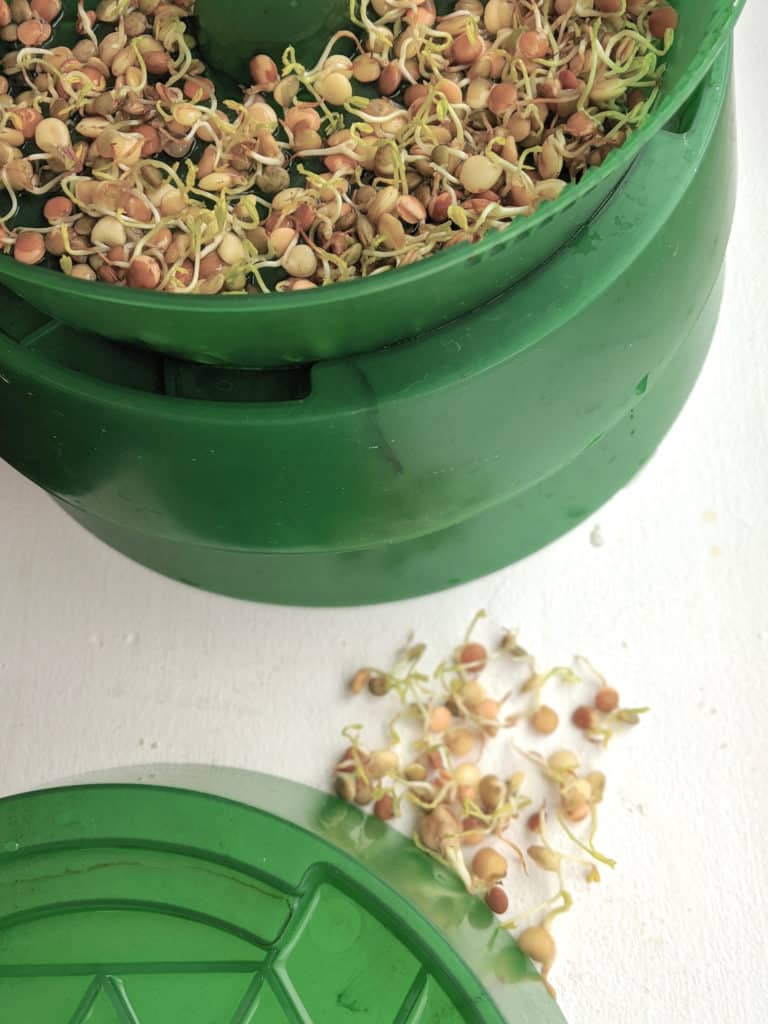
It turns out, great minds think alike, and I found out Jill was busy doing the exact same thing in a corner of her kitchen across the country.
Well, sort of.
You see, Jill didn’t have the gear that I do, so she was more creative than I had to be. She rigged up a resourceful sprouting solution with simple things she had on hand, and it’s working pretty well for her.
So today I’ll:
- Show you both of our set ups, to help you decide how you want to grow sprouts in your home.
- Break down why you should be eating sprouts–regardless of the current food supply situation in your state.
- List more than 2 dozen ways to eat these tiny, easy-to-grow powerhouses known as sprouts.
What Are Sprouts?
Sprouts are the beginnings of baby plants that have escaped their seed casings after you drench them with water and give them a few daily rinsings, for a few days in a row.
How are sprouts different than microgreens?
But I feel like I should explain how sprouts differ from microgreens, because I remember when I first learned you could actually grow your own sprouts at home, I was very confused about how they compared to microgreens. While both have great nutritional benefits, I’ve never ventured into the world of microgreens. Because I started with sprouting, and now that I understand the difference, sprouting seems so much easier.
Basically, microgreens are much larger mini-plants than sprouts, and they require dirt and sunlight to grow.
Sprouts need neither sunlight nor dirt to grow, so they can be easily grown almost anywhere. Even in the dark corner of my kitchen that is otherwise pretty unproductive.
Are sprouts I grow at home different than ones at the store?
While home-grown sprouts are, for the most part, the same as you can buy at the store, there are 2 main differences:
- Homegrown sprouts will save you money.
- Homegrown sprouts will give you lots more variety.
If you’ve ever bought sprouts at the grocery store, you’ll love how much money you can save by growing your own sprouts.
Plus, when you learn how to grow sprouts at home, you choose from a wide assortment of sprouting seeds. You can experiment and discover the tastes you like best–from the slightly spicy taste of radish sprouts to the gently sweet option of fenugreek sprout–and even make your own unique assortment of sprouts.
What combination of sprouts are delicious together?
One great combination is radish, fenugreek, red clover, and broccoli.
If you want to start off with some wonderful assortments that have already been put together for you, I love the two I’m growing in my kitchen this week. In fact, these two options are my favorite for snacking and putting on sandwiches and wraps. (More below for a long list of ways I love to eat sprouts.)
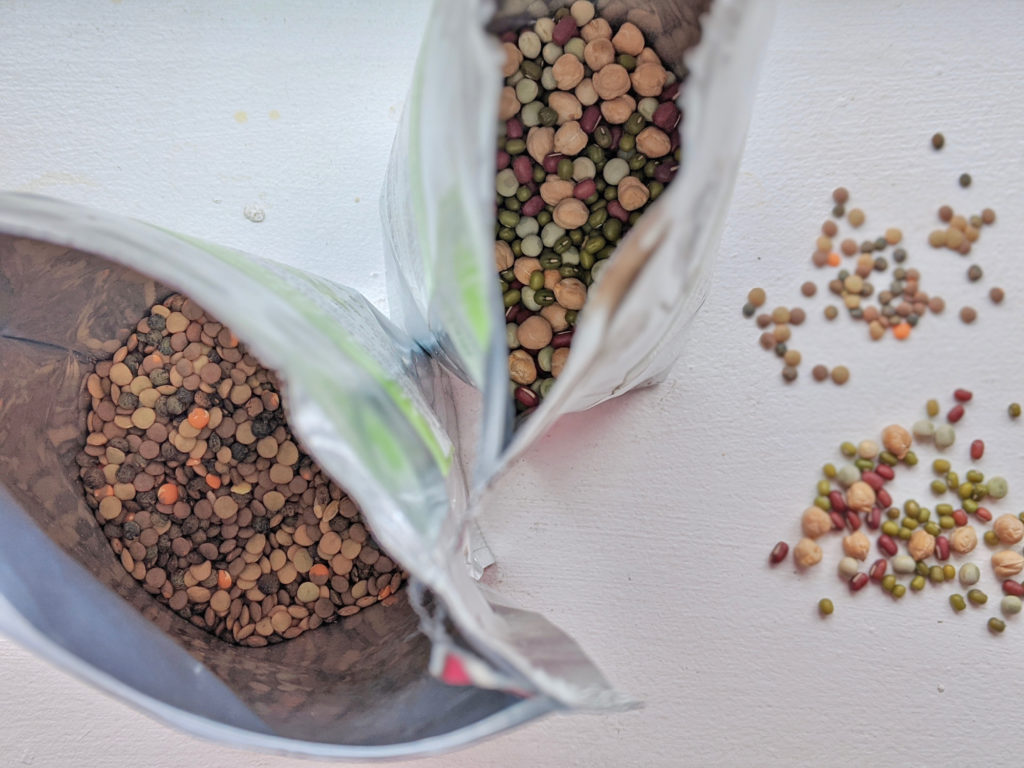
This this organic Crunchy Lentil Fest (pictured in the bag on the left) is my go-to for sandwich-topper sprouts.
And this organic Protein Powerhouse Mix (in the bag on the right) is my favorite, healthy snack when I want to do some mindless snacking and feel no guilt.
How to Grow Sprouts at Home
Certainly, there are other ways to get the job done when it comes to growing sprouts at home, but for the most part, you can work with things you already have at home, or you can invest in a streamlined, easy-to-use system.
Growing Sprouts in Jars
Jill’s simple sprouting set up works just fine for growing sprouts at home.
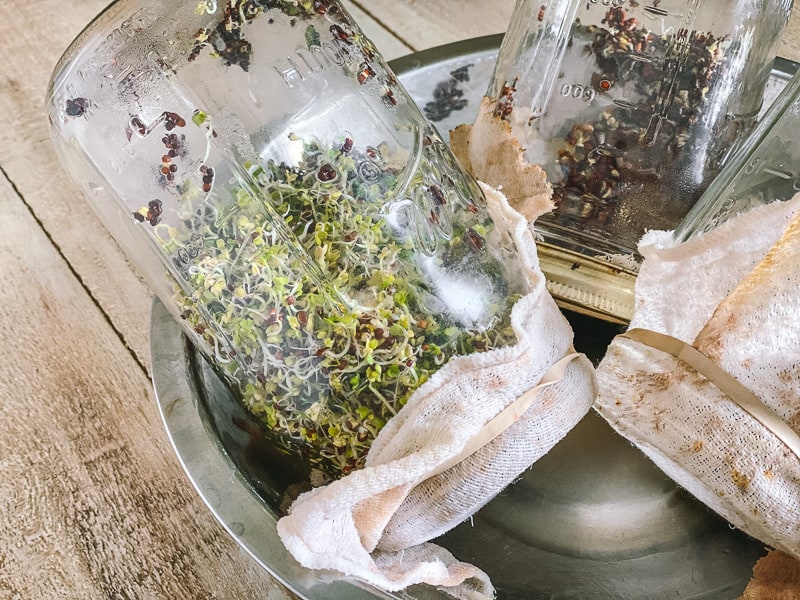
With a few simple items you have laying around in your house today, you can create your own sprouting system.
What do you need?
- A few mason jars
- A few squares of fabric
- A few rubber bands, or canning rims to fit your jars
- A sieve like this one (affiliate link)
- Or sprouting lids like these (in place of fabric, rims, and a sieve)
- Sprouting seeds like this super sampler
Why grow sprouts in jars?
- Minimal start-up costs (if any)
- Nothing to store, when you’re not sprouting (if you ever go without sprouting again, once you start)
The steps to using jars for sprouting:
- Place sprouting seeds in a mason jar. No need to start with a lot, maybe 1/2 a cup.
- Soak your seeds overnight (or about 12 hours) in lukewarm water in a lidded mason jar, covering the seeds with water that is 3x the depth of the seeds. Store the jar of soaking seeds in a cabinet or other dark area.
- Drain the water from the seeds (this is where your sieve comes in handy if you don’t have a fancy sprouting lid) and prop your jar so that residual water can continue to drain.
- Keep your propped jar out of direct sunlight and covered with a towel.
- Rinse your sprouts with cool, fresh water a few times every day for 2-4 days, or until sprouted (when you see tiny plants have emerged from the seeds).
- After each rinse, be sure to secure your fabric (if you don’t have a sprouting lid) and prop your jar upright, to allow residual water to drain.
- When seeds have sprouted, remove sprouts from jar and clean and dry your jar. Then place sprouts back in the jar and place in indirect sunlight for 12-24 hours. The sprouts will produce chlorophyll and carotenes and are then ready to be enjoyed.
- Lay out any sprouts you don’t eat right away on a linen towel to air dry before storing them away in the refrigerator, where they should keep well for at least 4-5 days.
Growing Sprouts With a Sprout Garden System
I’ve tried the mason jar route and wasn’t too crazy about it. Once I invested in this fancier system, I have been a sprouting fiend and love the process.
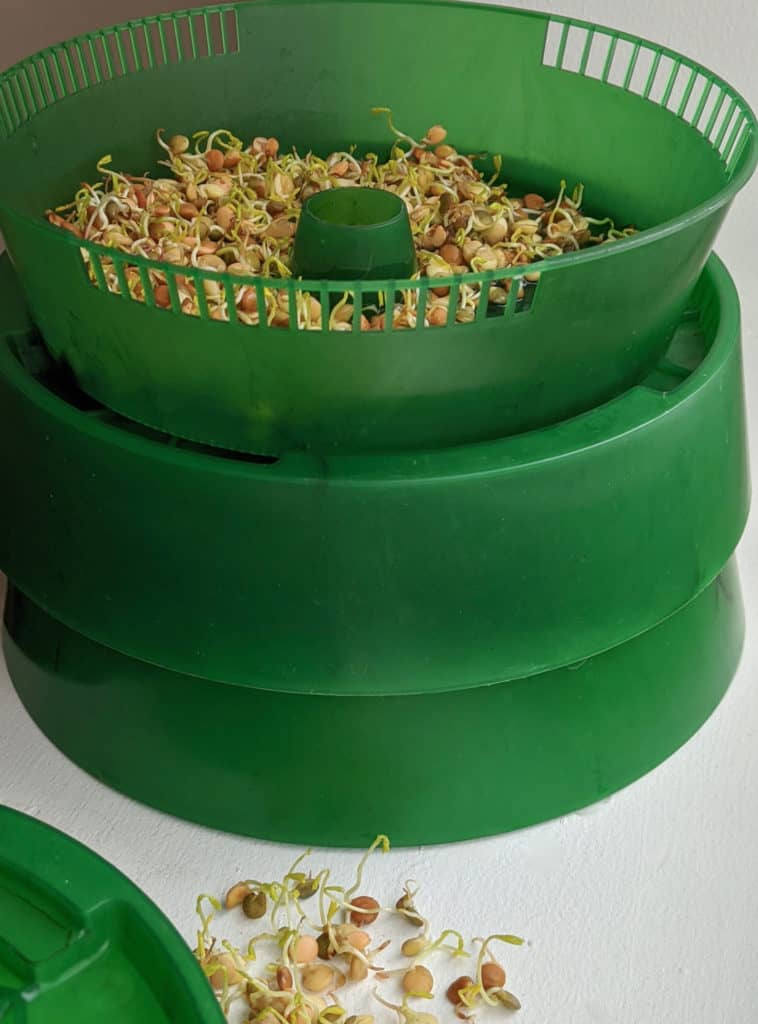
Right now, only through Sunday, March 22nd, you can grab my favorite sprouting kit at 15% off! Just use coupon code SPROUTS15.
What do you need?
- A sprout garden, which comes with 3 levels of growing surfaces.
- Sprouting seeds like this super sampler
Why grow sprouts with a sprout garden?
- This one simple system lets you grow multiple levels of many sprouts at once. Or, of course, you can choose to just grow one level at a time.
- This system takes up minimal counter space, with maximum amount of sprouts, since you could even invest in two sets, and still take up no more space on your counter.
- Daily maintenance is super easy, with no extra tools required (like a sieve).
- No need to worry about covering things with a towel or keeping the growing sprouts in a dark area. The lids protect your sprouts from both light and airborne contaminants.
- No need for rigging some sort of a draining tray or bowl. The system comes with 3 grow trays and 4 lids, which serve to cover the sprouts below while collecting draining water from the sprouts above. There are 4 lids, so when you are using all 3 trays one lid is still available to serve as the bottom base for your sprout garden.
The steps to sprouting with a sprout garden:
- Place sprouting seeds an upside down lid (the trays have drainage slits; the lids/bases do not). No need to start with a lot, maybe 1/2 a cup.
- Soak your seeds overnight (or about 12 hours) in lukewarm water right in the lid, covering the seeds thoroughly with water. Place another lid on top, or store soaking seeds in a dark area.
- Transfer the seeds to a sprout tray. The water will easily drain out of the bottom drainage holes. Rinse the sprouts with a gentle stream of tap water and shake the tray to somewhat evenly disperse your sprouts around the tray.
- Place a lid over your sprout tray and set it on a base.
- Rinse your sprouts with cool, fresh water a few times every day for 2-4 days, or until sprouted (when you see tiny plants have emerged from the seeds).
- When sprouted, set trays in indirect sunlight, without lids. The sprouts will produce chlorophyll and carotenes in the following 12-24 hours and are ready to be enjoyed.
- Lay out any sprouts you don’t eat right away on a linen towel to air dry before storing them away in the refrigerator, where they should keep well for at least 4-5 days.
- Thoroughly clean all trays and lids of your sprout garden with hot, soapy water and a scrub brush.
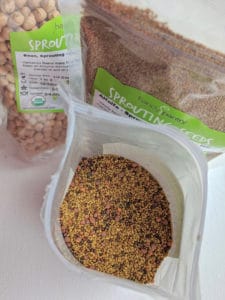
Other Sprouting Set Ups
There are many options out there if you’re looking to purchase a sprouting set up. While I love my 3-tray, stackable sprout garden, I feel I should point out that you can do a simple google search and find many options for great ways to sprout seeds at home.
I love the looks of this Seed Sprouting Jar Kit with wire stands for holding your jars at the right angle and a nice tray for collecting the water that drains out. And these sprouting lids are pretty ingenious, allowing you to stand your jar totally upright to drain.
Why Should You Eat Sprouts?
I had heard recently that early Chinese sailers always had sprouts growing on their ships because they knew they were a nutritional way to avoid disease, not unlike the way that later European seafarers ate citrus fruit to avoid scurvy.
While I found the tale of Chinese maritime sprouts fascinating, I had no idea if the sailers knew what they were doing until I stumbled across this scientific research. It turns out modern science gives great credence to the wisdom of those ancient sailers.
Sprouts appear to:
- act as anti-inflammatories
- possibly reduce the risk of cancer
- prevent allergies
- decrease blood pressure
- improve changes against heart disease, and
- fight diabetes
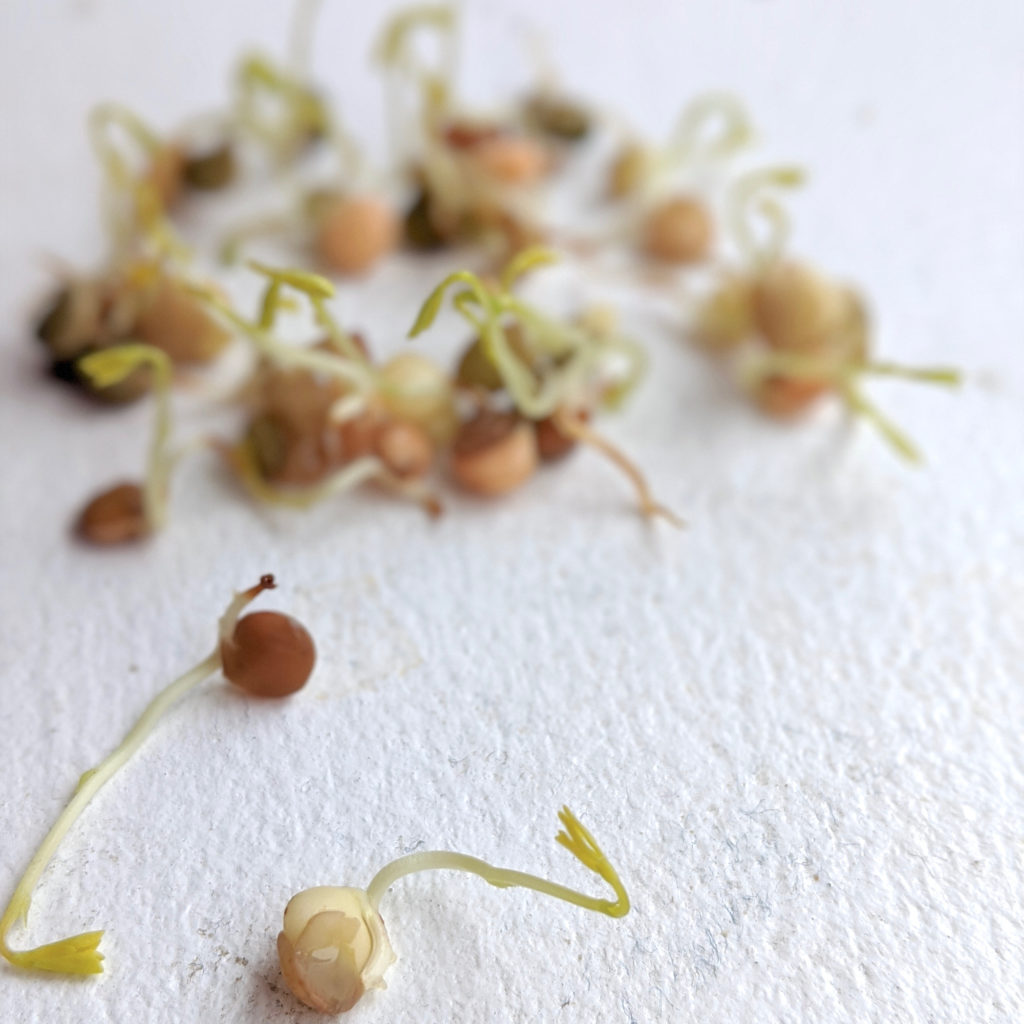
It turns out, sprouts are:
- Low in calories
- High in proteins
- Almost entirely fat-free
- No-cholesterol, no-sodium snack options
- Filled with enzymes
- Loaded with essential amino acids
- High in vitamins
- Rich in minerals
- Filled with energy-boosting carbohydrates
- A great source of vitamin C
More Than Two Dozen Delicious Ways to Eat Sprouts!
Since sprouts are vegetables, they can be used in all vegetable dishes. The most nutritious options are always uncooked ones, such as using your sprouts on a tossed salad or replacing lettuce with sprouts on your favorite sandwiches. If you do use sprouts in a cooked dish, add them in at the end when possible to preserve as much of their nutrients as possible. Here are a few great ways to eat your sprouts:
- Add to tossed salads, with my Jill’s dessert smoothie or Jill’s dessert smoothie.
- Use in coleslaw.
- Add to potato salad.
- Add to stir-fry.
- Blend into smoothies, like Jill’s dessert smoothie or my pineapple & spinach smoothie.
- Use instead of celery in tuna salad.
- Add onto a chicken salad sandwich instead of lettuce. (This was my lunch today; and I used fresh avocado instead of mayonnaise, so my plate was beaming with green, healthy goodness, in the middle of a cold March day.)
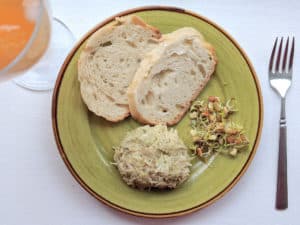
- Grind up and add to homemade mayo.
- Mix spicy sprouts, like radish, with soft cheeses (like homemade cream cheese) for a veggie dip.
- Add as a crunchy topping to soup, like this delicious cheeseburger soup.
- Stir mung bean or lentil sprouts directly into your soup, right before serving.
- Top a grilled cheese sandwich after it’s grilled.
- Mix buckwheat sprouts into pancake or waffle batter.
- Grind up sprouts and mix them into mashed potatoes.
- Add alfalfa or clover sprouts to potato cakes (my family’s favorite way to reheat leftover mashed potatoes).
- Add to scrambled eggs.
- Sprinkle on top of over-easy eggs.
- Mix into omelets.
- Add fenugreek, lentil, or mung bean sprouts into rice dishes.
- Mix alfalfa sprouts or clover sprouts into spaghetti sauce, right before serving.
- Saute with onions.
- Add to baked beans.
- Steam lentil sprouts or mung bean sprouts and serve with butter.
- Use as an edible garnish.
- Just pop them in your mouth, raw, as a so-good-for-you snack. Garbanzo bean sprouts are my favorite for this.
The Rules of Sprouting
Keep these 5 “rules” in mind and I think you’ll have delicious success in your sprouting adventures:
- Be sure to rinse 2-3 times a day, every day.
- Keep your sprouts moist, but not wet.
- Try to keep them at a stable room temperature, when possible, of around 72°F.
- Give your sprouts plenty of room to breathe, not putting too many in one jar or tray.
- Keep sprouts covered and away from light.
Sprouting Q & A
Q. Can I use garden seeds as sprouting seeds?
A. No, I would never use garden seeds to do my sprouting. For two reasons, one it would be much more costly. And, more importantly, seeds used for planting in gardens are often treated with chemical fungicides and mercury coatings, which of course can be highly toxic. And if garden seeds are imported, they’re required to be dyed for identification.
Q. Can I use sprouting seeds as garden seeds?
A. You can certainly try. It might even be a fun experiment with the kids to test them out. But in general, you won’t find that many sprouting seeds are a good choice as gardening seeds. Sprouting seeds are cultivated to be prone to bolt as young plants. This produces many seeds in a short time period (good for sprouts) but does not make for healthy, mature plants or a good mature food source.
Q. Can I clean off the mold if I see a little growing on my sprouts and still eat them?
A. Sorry, but no. Never eat seeds or sprouts that have even a tiny bit of mold. Growing mold can produce mycotoxins, which can cause food poisoning.
Q. Can I freeze my sprouts?
A. No, sprouts are frost sensitive, so you can’t freeze them. But they do keep in the refrigerator for many days, or even weeks, if cared for properly.
Q. How can I extend the life of my sprouts?
A. I’m told you can maximize the life of sprouts by rinsing them every few days that they are stored in your refrigerator. I’ve never gone to this effort, mainly because sprouts simply never last that long around here. I’ve gotten good at anticipating how many I should be growing every week, and I keep finding new ways I love to incorporate them in my family’s diet. But, if you want to try rinsing them while you’re storing them, give the sprouts an hour or so of sunlight after you rinse them every 2-3 days, and your sprouts will stay at their nutritional peek for up to two weeks.
Q. Does it matter where I purchase my sprouting seeds?
A. You have many options for where to stock up on sprouting seeds. Whenever you can buy locally, that’s always a best bet. One thing I would caution you against is buying cheap, bulk quantities, especially if you don’t know your source. Often the cheaper, bulk options have a poor germination rate. This leaves some seeds in your jar or tray that never sprout and instead spoil the whole batch by fermenting and tasting bitter.
If you want to invest in a sprouting kit that will be making loads of sprouts for you for years to come, grab this basic sprouting kit at 15% off! Be sure to use coupon code SPROUTS15.
Need more inspiration when you can’t run to the store?
- The Easiest Bread Recipe EVER
- Homemade burger buns
- Make-your-own bagels
- DIY kombucha
- Sourdough tortillas
- Homemade pasta noodles
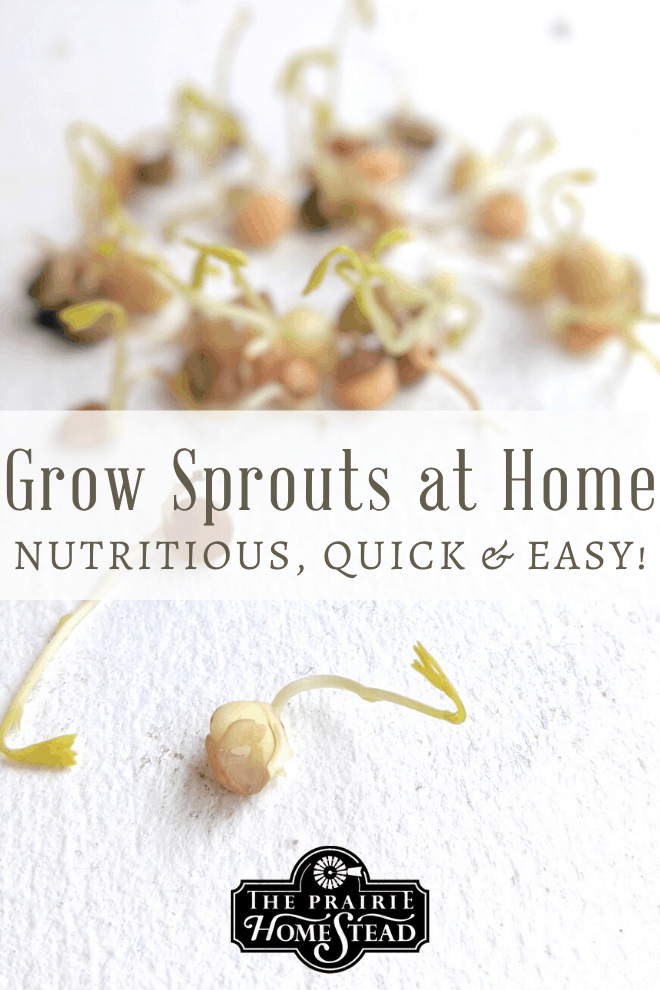
The post The Ultimate Guide to Growing Sprouts appeared first on The Prairie Homestead.
Via Gardening http://www.rssmix.com/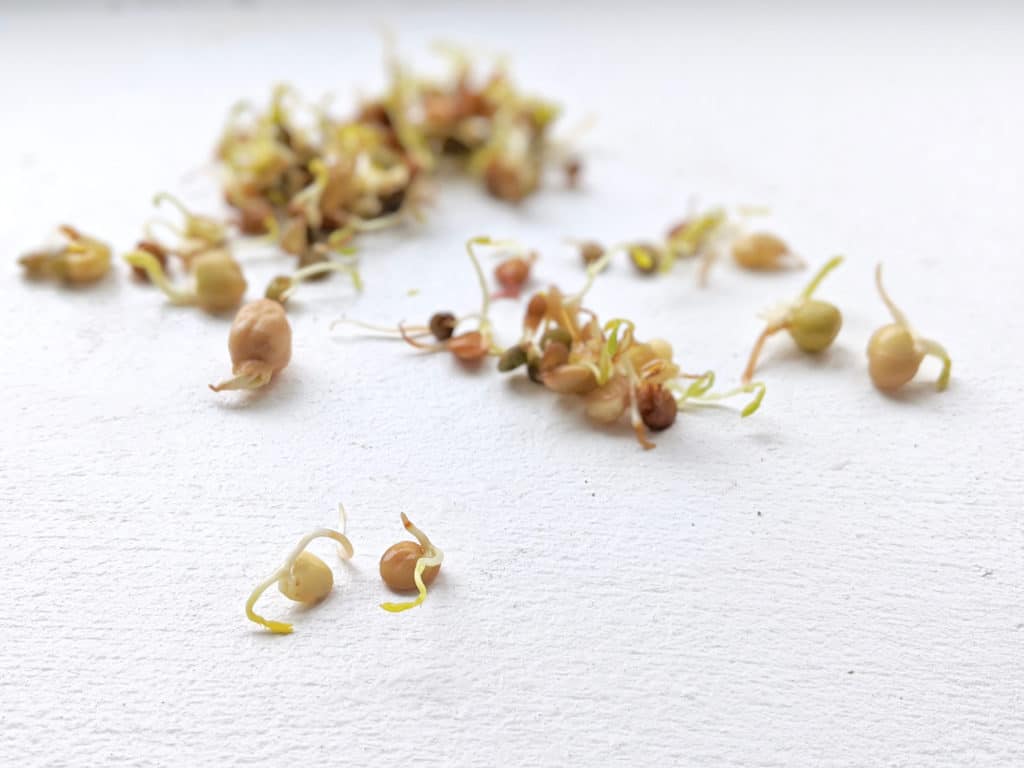
No comments:
Post a Comment